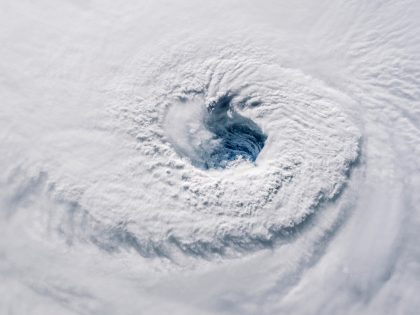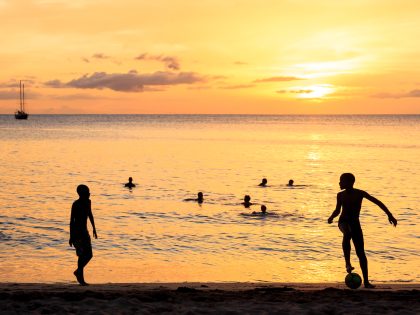Mythologies of the Future
Johannesburg artists investigate power and its structures to interrogate the invisible forces that create them and to imagine alternatives.

Painting by Pamela Phatsimo Sunstrum.
The phrase “Space is the Place” recalls the 1970s work of Sun Ra — father of Afrofuturism. It also resonates in the minds of artists both on the African continent and in the diaspora today. Afrofuturism is not tethered to a specific discipline or medium; because it depends on interdisciplinary borrowing, it allows for new ways of interacting with science fiction, art, the world at-large, and of course, cosmic philosophy.
Two artists making waves with their Afrofuturist collaborations are Pamela Phatsimo Sunstrum and Thenjiwe Niki Nkosi — who are currently living and working in Johannesburg, South Africa. Hailing from Mochudi, Botswana, Pamela Phatsimo Sunstrum works with drawing, animation, installation and performance. Her creative research interests include exploring the political possibilities of imagining and occupying what she calls “Mythologies of the Future.” Since, the early 1990s, Thenjiwe Niki Nkosi has lived in Harare and Johannesburg, on and off. She is a painter, video artist and filmmaker who splits her time between studio work and navigating the field of collaborative practice. Her work investigates power and its structures — political, social, and architectural, in order to interrogate the invisible forces that create them and ultimately imagine alternatives.
Though these two artists engage with different forms of conceptual and aesthetic expression, each constructs a world that pushes the viewer to critically rethink one’s positioning with respect to time and space. When I visited their shared studio in Selby, located in the Johannesburg CBD, I could see these clear divergences immediately. Their powerful partnership and camaraderie was even more refreshing and energizing to witness, especially when they spoke about their collaborative performance art piece, an ongoing Afrofuturist anti-opera entitled “Disrupters, THIS IS Disrupter X.”
While the form of the opera traditionally provides both a linear narrative and clear division between performer and viewer, Sunstrum and Nkosi’s piece manifests itself differently in each iteration — making it both site-specific and deliberately open-ended. For example, in 2014 Sunstrum and Nkosi constructed a living maquette in which visitors had to physically navigate through in order to experience the anti-opera. This work was the result of their one-month residency at Iwalewahaus, University of Bayreuth — an archival laboratory and exhibition space dedicated to the production and presentation of contemporary art from Africa.
While given the task of visualizing a work that activates certain objects from the Iwalewahaus’ collection of African art, Sunstrum and Nkosi found themselves focusing on the tools of the archive — the instruments with which the ‘master narratives of history on the African continent have been constructed. They then used objects of force and beauty — such as guns and sculptural masks — as anchors and points of inspiration for key elements of their own video projections, electronic sound compositions, and live choreography, which resulted in one deeply sensory, complex and satisfyingly unpredictable Afrofuturist experience. With these elements, Sunstrum and Nkosi presented the character “Disrupter X”, who is on a mission to find the mysterious “Geomancer” — a powerful machine that can predict the future and is the last hope for her salvation from “The Agency,” a brutal and powerful entity that easily resembles today’s transnational corporations.
From this intensely visceral performance piece, in which collaboration lies at the very heart of the process, the clear departures between Sunstrum and Nkosi’s studio praxes then begin to make more sense. Sunstrum and I spoke about Asme, the female figure who used to recur regularly in her work, but whom recently she has forgone in order explore what it means to convey a compelling narrative solely through landscapes. These scenes embody the latest iteration of her science fictional and mythological explorations, and can be interpreted as simultaneously primordial and futurist — the cinematic panoramas giving a sense of continual oscillation between past and future.
Nkosi mused on the part of painting that she revels in the most — that moment when the shadow and contour just cleanly run parallel to each other, barely grazing one another to give a satisfaction that can only be gleaned from architectural space being manifest on a two dimensional surface. She notes how this painterly habit became especially challenging to her with her 2013 portrait series, which focused on valorizing the perspectives of South African heroes —those known and unknown, subsumed and un-subsumed into the popular archive.
These nuanced and semipermeable boundaries between Sunstrum and Nkosi’s respective praxes present an interesting way that artists can collaborate while retaining a strong sense of independence. They spend a great deal of time work-shopping and revising each other’s theoretical strategies, leading to work that reflects their thoughtful and deliberate approach to the conceptual and aesthetic components of their work, always inquiring and re-thinking in order to present the most precise articulation of their processes.
This unique dynamic follows through in their approach to exhibiting work. Through ‘joint solo shows’, Sunstrum and Nkosi don’t ask viewers to look for links between their work, but rather engineer these exhibitions in order to combat the solo show model that is ubiquitous within dominant art world structures. The do not put their work in dialogue, but allow it to coalesce in their own radical re-imagining of the spaces in which it is deemed acceptable. I for one am excited to see where their work takes them, and us, next.



















